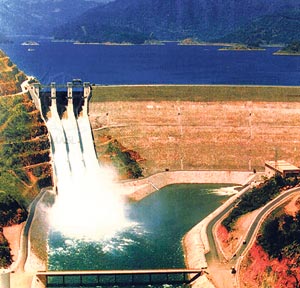It's 28 years since Randenigala, the largest reservoir
constructed under the Accelerated Mahaweli Development Programme was opened by President J. R. Jayewardene
marking a significant milestone in the biggest river basin development programme conceived in Sri Lanka.
While the reservoir
manages Mahaweli water, which is being released to Mahaweli C and Mahaweli B zones, the Randenigala hydroelectric power station generates 126 megawatts
of electricity.
The project mainly consisted of the construction of a 94 m high, 485 m long rock-fill dam across the Mahaweli river, creating a
reservoir of 860 million cu.m., and building a power house on the left bank immediately downstream of the dam. It also included the
construction of a steel lined tunnel 6.2 m diameter, 270 m long to
convey water to the power house to run the turbines. The triple gated chute spillway is capable of
discharging the probable maximum flood waters.
There are a number of islets
within Randenigala which adds beauty to it. In addition, the Randenigala dam provides a
spectacular view. It can be accessed though Raja Mawatha from Kandy or through Mahiyangana-Minipe Road.
The Randenigala Project, the fourth major multi-purpose under the Mahaweli Programme is located about 26 km below Victoria and 6 km upstream of Minipe anicut. From here, the main right bank and left bank canals divert the Mahaweli waters for irrigation. It is also the reservoir with the largest storage capacity, at full supply level.
It was in November 1982, that construction work on the Randenigala Project, one of five major Mahaweli projects, was
started. Its power potential was considered crucial for meeting the power shortfall forecast for 1986.
By the time work in the Randenigala project was begun, several others under the Mahaweli Development Programme were already underway. The first project in the Master Plan was the Polgolla diversion which had been
inaugurated in February 1970.
It was commissioned in February 1976. By early 1976, 52,800
hectares of existing paddy land in the Anuradhapura, Polonnaruwa and Trincomalee districts were benefitted by the Polgolla and Bowatenna complexes. By 1984, 28,800 hectares of new land in the Kandalama and Kalawewa areas known as System 'H' had been
completed.
The progress of the development project meant settling farmer
families, setting up of new
townships, village centres and
hamlets. At the same time
facilities for vital necessities like education, health and agriculture had to be provided.
The largest integrated rural development multi-purpose
programme ever undertaken in
Sri Lanka was based on water
resources of Mahaweli and allied six river basins. Main objectives were to increase agricultural production, hydro-power generation, provide employment opportunities,
settlement of landless poor and flood control. The programme was
originally planned for the
implementation over a 35-year period.
In 1977, after a new government with J. R. Jayewardene as Prime Minister was elected, it was
decided to accelerate the
implementation of the Programme. For this purpose a separate
ministry titled the Ministry of Mahaweli Development was
established in 1978, with
Hon. Gamini Dissanayake, Minister of Lands & Land Development being given the responsibility of the speedy implementation of the
development programme. A separate authority, The Mahaweli Authority of Sri Lanka was created in 1979, to be in charge of all aspects of the
programme.
A major factor for the success of the Programme was the ready response of several countries to finance the various headworks under the Project. The Government of the United Kingdom agreed to finance the Victoria Project, Canada the Maduru Oya Project, Federal Republic of Germany the Randenigala Project, Sweden the Kotmale Project and Japan the Moragahakanda Project. Meanwhile, the Governments of USA, Canada, Japan, Saudi Arabia, Kuwait, Australia and International Agencies agreed to finance the downstream
development. |



